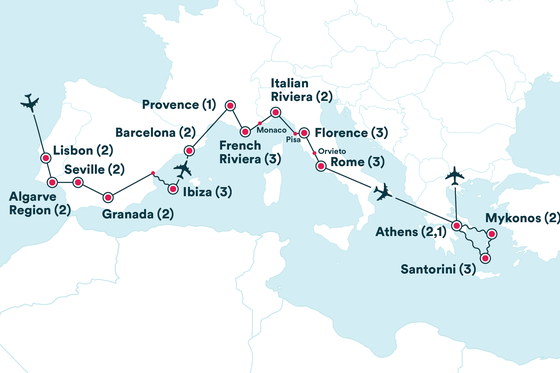The Art of Rowing in Venice: A Local’s Perspective
Voga alla veneta is more than just a rowing style, it’s a way of life.
When you think of Venice, the image of gondolas gracefully gliding through its iconic canals likely comes to mind. Which makes sense—it’s a city of 118 small islands with no roads. But to Venetians, rowing is more than just a touristy experience, it’s a ritual, a passion, and a tradition that’s been passed down from generation to generation.
We were lucky enough to pay a visit to Row Venice, a women-owned organization dedicated to the preservation of rowing culture. Come along as we learn the art of voga alla veneta and discover how and why it’s stood the test of time.

Meet our instructors
Elena and Viola, our instructors from Row Venice, embody the spirit of Venetian rowing heritage. They dedicate their time to teaching visitors how to row, sharing their love for the water, and teaching the history of this unique tradition. “The grandfathers used to teach children how to row because it was a safe job,” Viola explained. “Even if you didn’t study, if you knew how to row, you could transport goods around.” Elena and Viola’s tour wasn’t simply centered around teaching us how to row, but rather on connecting us to the city in a visceral and physical way.
The tradition of rowing
Rowing in Venice isn’t just about moving through the water, it’s about connecting with the city and its history. The tradition of rowing is deeply intertwined with Venetian culture, dating back centuries. As long as Venice has stood (since 8 AD!), a flotilla of small watercraft have filled its canals, fueling and sustaining day to day life. “When you’re in the water, you have a different point of view,” Elena told us. “This city is alive, and rowing allows you to fall in love with it all over again.”
Learning to row
Our rowing lesson began with an introduction to the techniques of voga alla veneta. Unlike the conventional rowing style, this method involves standing at the back of the boat, facing forward, and using a long oar to propel the vessel through the water.
Rowing takes an incredible amount of both skill and balance, and each paddle stroke needs to be executed thoughtfully—afterall, the paddle isn’t just meant to move you forward, it helps you to turn and to navigate your way through sometimes narrow canals.
As we practiced, we couldn’t help but admire the beauty of the batela—a traditional Venetian boat designed for this very purpose. Its elegant lines and craftsmanship were a reminder of the artistry that goes into every aspect of Venetian culture.
Initially, we practiced in calm waters, surrounded by the quiet charm of outer Venice. It felt surprisingly challenging to maintain a straight course while mastering the return stroke. But with Elena and Viola’s guidance, we started to feel the rhythm of the oar and the water. “You have to understand the nature around you,” Elena advised. “Look at the tide, the wind—respect the place you are in.”
After gaining some confidence, we ventured into the narrow canals of Venice. It. Was. Magical. As we glided through the waterways, the ancient buildings and vibrant life around us came alive in a way that you simply cannot find on the sidewalks and bridges of the city.
A connection to the city
Rowing through these canals allowed us to witness daily Venetian life from a new angle. The bustling streets faded into the background as we focused on the rhythm of the oar and the serene beauty of the surroundings. Each stroke felt like a dance with the water, and we found ourselves appreciating the skill and artistry involved in navigating these historic waterways. Rowing through the Venetian canals, it was easy to picture ourselves centuries in the past, gliding our way from building to building.
What to expect when you row
So, what should you wear and bring along for your rowing adventure? Dress comfortably in casual clothes that allow for movement. If you’re visiting in the summer, don’t forget sunscreen and a water bottle, as you’ll be out in the sun for a while. The instructors often row barefoot, but sturdy sandals or shoes with a good grip are great, too. And last but not least, bring a camera (or at least your phone)—the views from a batela cruising through a Venetian canal are second to none.
One last thought
Whether it’s your first trip to Venice or you’re heading back for more, you have to consider signing up for a rowing lesson with Row Venice. It’s a hands-on experience that not only teaches you the art of rowing, but also provides a deeper understanding of Venice’s rich, water-based culture. Plus, how many people do you know who’ve posted a photo of themselves actually rowing in Venice?



























)






































)
























